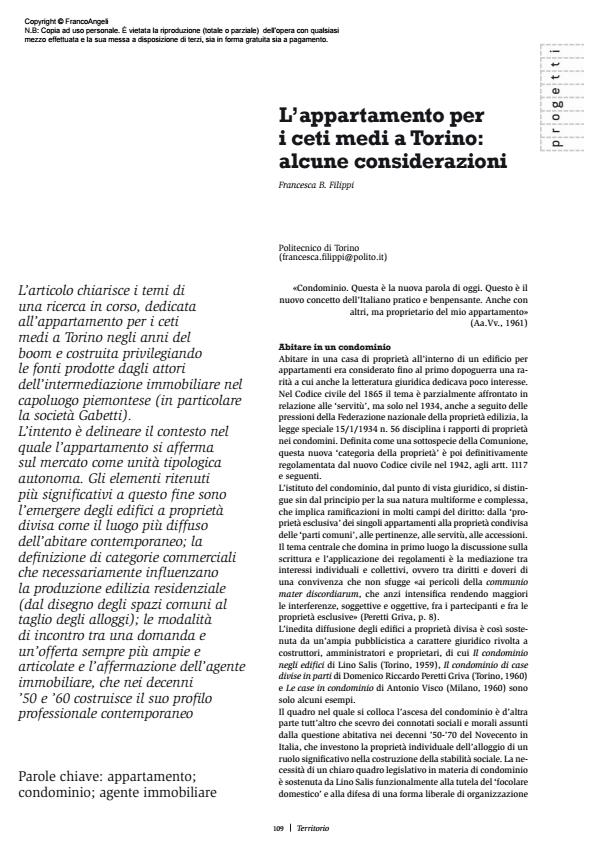The apartments for the middle classes in Turin: some considerations
Journal title TERRITORIO
Author/s Francesca B. Filippi
Publishing Year 2013 Issue 2013/64 Language Italian
Pages 7 P. 109-115 File size 604 KB
DOI 10.3280/TR2013-064018
DOI is like a bar code for intellectual property: to have more infomation
click here
Below, you can see the article first page
If you want to buy this article in PDF format, you can do it, following the instructions to buy download credits

FrancoAngeli is member of Publishers International Linking Association, Inc (PILA), a not-for-profit association which run the CrossRef service enabling links to and from online scholarly content.
This paper focuses on the themes of a research project currently in progress on apartments for the middle classes in Turin during the boom years. It makes primary use of sources furnished by operators in the estate agency sector in this regional capital of Piedmont (the company Gabetti in particular). The intention is to define the context in which apartments became the principal independent type of housing unit on the market. The factors considered most important for this purpose are the emergence of shared ownership properties as the most common sites for contemporary housing; the definition of commercial categories which necessarily influenced residential building production (ranging from the design of communal spaces to the size of accommodation units); the ways in which supply and demand met, which were increasingly broader and more complex; and the success of the estate agent which established its contemporary professional image during the 1950s and 1960s.
Keywords: Apartment; condominium; estate agent
- Bianchetti C., 1985, La questione abitativa. Processi politici e attività rappresentativa, FrancoAngeli, Milano.
- Bravi M. e Ferrero D., 1989, «Città e mercato immobiliare. Trasformazioni della proprietà a Torino negli anni ’50-’60 del ‘900», in Curto R. (a cura di), Città e valori. Mercati e presenze dell’economia a Torino 1800-1980, Celid, Torino, pp. 223-256.
- Curto R., 1984, Mercato, formazione e trasformazione dei valori fondiari ed edilizi. Il caso di Torino, Celid, Torino.
- Curto R., 1992, «Un mercato che si frammenta», in Olmo C. (a cura di), Cantieri e disegni. Architetture e piani per Torino 1945-1990, Umberto Allemandi, Torino, pp. 123-150.
- Fazio M., 1959, «Perché gli affitti non scendono mentre migliaia di case sono vuote», La Stampa, domenica 20 settembre, p. 11.
- Negro U., 1959, «L’agente immobiliare», Notiziario quindicinale d’affari Gabetti, 1 settembre, n. 7, p. 1.
- Negro U., 1960, Manuale - Guida dell’Agente di Affari in Mediazione, Arti Grafiche Castore, Torino.
- Oliveri, L.C., 1961, «Cerco Casa», Grazia, 22 ottobre, pp. 102-109.
- Peretti Griva D.R., 1960, Il condominio di case divise in parti, Utet, Torino.
- Salis L.,1959, Il condominio negli edifici, Utet, Torino. Redazionale, 1955a, «Il ‘piano Torino-casa’ nel settore delle costruzioni signorili», La Nuova Stampa, 18 marzo, p. 2. Redazionale, 1955b, «La situazione edilizia e il costo degli appartamenti nuovi. Dai due milioni per un piccolo alloggio ad un massimo di tre milioni per vano», La Nuova Stampa, 8 giugno, p. 2.
- Redazionale, 1960a, «Intervista al dott. Rosboch, commercialista torinese e Assessore al Turismo della Civica Amministrazione», Notiziario quindicinale d’affari Gabetti, 1 aprile, n. 21, p. 1.
- Redazionale, 1960b, «Via i clandestini», Notiziario quindicinale d’affari Gabetti, 15 giugno, n. 26, p. 8.
- Redazionale, 1961, «Appartamento in proprietà. Un desiderio che si realizza », Notiziario quindicinale d’affari Gabetti, 15 ottobre, n. 56, p. 1.
Francesca B. Filippi, L’appartamento per i ceti medi a Torino: alcune considerazioni in "TERRITORIO" 64/2013, pp 109-115, DOI: 10.3280/TR2013-064018